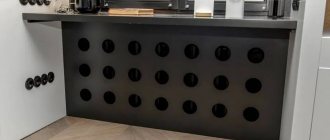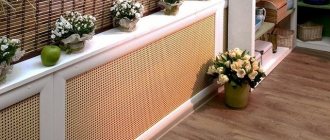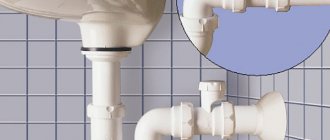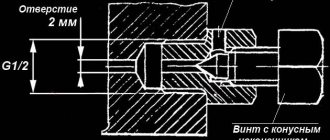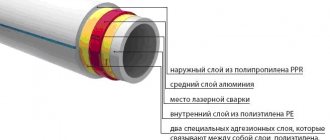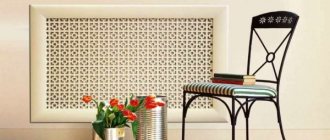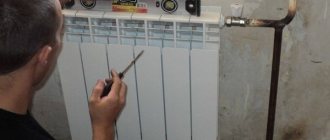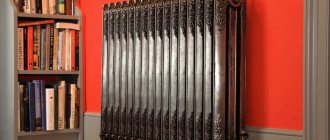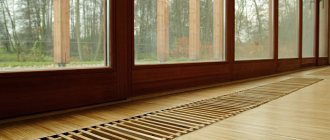The most modern designs of heating radiators do not fit easily into the interior of a living space, let alone traditional cast iron radiators located in the most prominent places in the room - under the windows.
To disguise radiators, decorative screens are used, made from materials that best suit the style of the interior. In addition to decorative purposes, they are also installed on radiators for safety reasons . In educational and sports institutions, radiators are covered with protective grilles to prevent injuries to students.
A little about heat engineering and radiator grilles
Even if you need radiator grilles for decoration, do not forget that the radiators must heat the room. Any screen reduces heat transfer, even the most delicate and delicate one. Another question is that one will reduce the amount of heat transferred by 10-15%, and the other by 60% or even more. It is unlikely that you will want to sit in a beautiful but cold room, so when choosing a decorative grille you need to take into account how the heat will spread.
Heat Spread
The principle of heat transfer from a heating radiator without a grille is shown in the figure. The main idea is that air should come from below, pass along the battery, heat up, and go up. This is how our heating works. When choosing a grille or screen, you need to remember this. For normal air circulation, it is necessary that there is a gap at the bottom and no cover at the top. As a last resort, the lid should have a large perforation area.
Not a bad option - large holes allow air to move freely
But if you look at many of the decorative grilles, you can immediately tell that the room will be cold. This especially affects grilles on heating radiators in the form of a box, which have walls on all sides. If they are very lacy, as in the photo above, there is no particular problem, but if they are made of solid wood (as in the photo below), with almost no or minimal perforations, be prepared for heating inefficiency.
The top of the battery is covered with a solid layer of wood without holes
Wood is, of course, an aesthetic material, but it has a high heat capacity. Until the wood heats up, the room will be cold. And since the array is located above the radiator and there are no holes for circulation, the radiator under such a grille will be hot, but the room will be cold.
The principle of heating a room
Decor is the main function of battery grilles. But radiators are used to heat the home, so there should be no obstacles in the way. Even the thinnest screens reduce heat transfer, so you should choose products with a low percentage of absorbed heat in advance.
Air should enter the radiator from below, pass along it, heat up and go to the top. This system will heat the room. Therefore, when choosing a grill for the battery, you need to make sure that there is a small gap at the bottom and that there is no cover at the top. It is possible that the top cover has a large perforation area.
Many modern decorative radiator grilles reduce heat transfer by more than 20%. Screens in the form of boxes made of solid wood lose a particularly large percentage of heat. Models with a minimum number of holes and a small perforation area will be ineffective in operation.
The screen additionally protects the radiator from dirt. Dust particles settle on a hot battery and decompose under the influence of high temperature. As a result, the surrounding atmosphere becomes polluted with decomposition products, which harms the health of people, especially allergy sufferers and asthmatics. When installing the grille, the accumulation of dust on the radiators is significantly reduced. Periodically you need to clean the screen with a cloth or vacuum cleaner.
Tasks and materials
Most often, grilles are installed on heating radiators for decoration - not all heating devices look attractive, but the grilles are sometimes made very beautiful. The second task that battery screens often perform is to cover sharp and hard edges. This is relevant in families with children, especially if old-style cast iron radiators, the “accordion” type, are installed. Their shape is dangerous, and their appearance is unattractive; they would only be suitable in loft-style rooms.
Grates for heating radiators are made from different materials:
- Metal screens for batteries are produced in large quantities. They are made from thin sheet steel, which is then coated with paint. For the most part, they don't cost much, but they also look average. The service life depends on the quality of the paint. Powder enamels are preferable. They last longer, maintaining their attractiveness for decades. From the point of view of the effect on heating, metal screens for radiators are the best choice. The metal heats up quickly, and then it begins to radiate heat. So the option is inexpensive (usually) and does not greatly affect the temperature in the room (if there is perforation).
The most common form, and the design can be anything - Forged grilles are very beautiful. But the forging is too delicate, so some kind of background is required, and it is often made contrasting in order to highlight the forged elements more clearly. To ensure normal air circulation, it makes sense to make the “background” from a perforated metal sheet.
The forging is very beautiful - Wooden grilles and screens. Wood has always been and remains a premium material. The high plasticity of the material allows them to be made in different styles and shapes. And although there are inexpensive products made from wood, they look very good. But, as mentioned above, a radiator covered on all sides with wood transfers little heat to the room.
Wood always looks solid - MDF and HDF. For production, laminated sheet materials are used. Staz should say that no binders are used in the production of MDF and HDF. The softened wood fibers are pressed, releasing lignin, a natural binder found in wood. Lignin is what glues fibers together. So both of these materials are absolutely safe. While we know products made from MDF more or less well, HDF is an unfamiliar material for many. It differs from MDF only in the pressing conditions. It is molded under higher pressure, as a result it is very thin (3-4 mm), but more dense and uniform. HDF holds its shape well, which is why openwork grilles for heating radiators are often made from HDF. From the point of view of their effect on heating, they are slightly better than wood - the layer is thinner, and there are usually more perforations.
Openwork decorative grilles for batteries are usually made from MDF and HDF - Plastic. Plastic products are most often used in bathrooms and toilets. This material is the most hygienic; it can be washed an unlimited number of times. For production, heat-resistant plastic is used, which is not afraid of heating up to 60-80°C. If the grill slats are installed at an angle, as in the photo, the heating will work efficiently. Air flows through the cracks unhindered. It all depends on how the lid is made.
Plastic washes well, is durable and unpretentious - Glass screens for radiators appeared several years ago. They are not ideal from a heating point of view, but they have an attractive appearance. They are made from special tempered glass, frosted or patterned.
Screen for glass radiators
Used in the manufacture of decorative grilles for radiators and more exotic materials. For example, bamboo and rattan. Such products are more demanding for interiors and are rare.
Rattan screen on wooden frame
There are also combined grilles. Most often there is a wooden frame on which some kind of decorative mesh is stretched. Bamboo and rattan wickers are most often attached to such a frame. MDF and HDF panels are usually mounted on a wooden frame.
What to consider when masking
Before performing battery masking, you need to pay attention to some points:
- it is necessary to understand that in any case there will be a loss of heat;
- there should be no barriers to convection air flows; this is the only way to maintain uniform heating of the room;
- it is necessary to think through everything correctly so that there is open access to the batteries in the event of an emergency;
- The faucet, thermal head and other components of the heating system must be accessible to carry out repairs.
These points must be taken into account; this is the only way to create an original accent in the room and ensure proper operation of the batteries.
Types and forms
In addition to different materials, radiator grilles come in different designs. All this together creates a huge number of options.
- Flat screens. Most often used if the radiator is installed in a niche. In this case, the flat panel is attached to bars fixed around the perimeter of the niche. In addition, glass screens for batteries also have this shape, but are attached to special pins embedded in the wall. This type of decorative grille for heating radiators is also called “facades”.
Flat screens are installed if the radiator is hidden in a niche - Hanging screens. There are two types: With a top cover. They are usually used on accordion-type batteries if the radiator protrudes beyond the window sill. The shape of the cover is made so that the grille holds onto the radiator without any problems.
- Without cover. Clings to the upper battery collector using hooks that are attached to the front panel.
Hanging grilles
Attached grille-box for radiator
These are only the main types of screens and grilles covering heating radiators. Fantasy is limitless, there are very interesting models, but they are most often made by craftsmen with their own hands.
Homemade screen - an original idea
Price often plays an important role when choosing a screen for a radiator. The range of prices in this segment is more than significant - from 230 rubles for a metal hinged screen, to 8,000 rubles for a glass one. Some prices are shown in the table.
| Radiator grille material | View of the grille on the heating radiator | Dimensions (height*width*depth) | Price | Color |
| Sheet metal, thickness 0.7-0.8 mm | Hinged screen for a cast iron battery | 27 cm * 29 cm * 15 cm | 230 rub. | White |
| Sheet metal, thickness 0.7-0.8 mm | Hinged screen for steel radiator | 44 cm * 39 cm * 15 cm | 250 rub. | White |
| Sheet metal, thickness 0.7-0.8 mm | Hinged screen for a cast iron battery | 61 cm * 49 cm * 15 cm | 280 rub. | White |
| Sheet metal, thickness 0.7-0.8 mm | Hinged screen for steel radiator | 53 cm * 49 cm * 10 cm | 350 rub. | Beige |
| MDF | Facade (flat screen) | from 1500 rub | 7 shades of lamination | |
| MDF | Box | from 2300 rub | 7 shades of lamination | |
| Glass | Screen | from 8000 rub | matte, no pattern | |
| Powder coated metal | Wall mounted with one side | 60 cm * 40 cm * 15 cm | 1790 RUR | colors upon request |
| Powder coated metal | Wall mounted with one side | 70 cm * 60 cm * 15 cm | 2050 rub. | colors upon request |
| Powder coated metal | Wall mounted with two walls | 60 cm * 40 cm * 15 cm | 2340 rub. | colors upon request |
| Powder coated metal | Wall mounted with two walls | 70 cm * 60 cm * 15 cm | 2600 rub. | colors upon request |
| Natural wood | Pristavnoy | from 6200 rub |
Unusual uses of a window sill
By installing a decorative screen for a radiator, you can significantly expand the area of the window sill. Thanks to this simple manipulation, you can turn the window sill into a real work desk or a relaxation area.
This solution will especially appeal to owners of small apartments, as it will save some space.
Mounting features
Grilles on heating radiators must be mounted in such a way that you can easily and quickly access heating appliances and pipes. Periodically, at least twice a year, the heating system elements must be cleaned of dirt and dust, so access is necessary. In addition, emergencies arise from time to time. In this case, a quick reaction is required and there is no time to unscrew the fasteners. Therefore, try to come up with a fastening system that allows you to remove the screen in one motion.
Attached and mounted
The easiest way is with mounted or attached screens. They are removed/retracted in seconds. But flat, covering radiators in niches and box screens that are attached to the wall are the most problematic. But even here everything is solved simply. You can secure the box to the wall using two strips: one on the box, the second on the wall. The whole secret is that the top edge of the planks is beveled (you can see it in the picture). The one that is nailed to the wall has a slope towards the wall, the one on the frame has a slope towards the grating. When the box is installed in place, it turns out something like a lock.
How to fix a screen box for a heating radiator on the wall
Another option is to attach metal plates to one of the strips and magnets to the other. Or attach not a wooden plank to the wall, but a metal corner, for example.
In the case of flat screens, the solution may be the same - metal plates and magnets. Another option is hooks and loops. It is easy to implement, but not very convenient to use: while you get into loops, you have to suffer. There is also a difficult-to-install but convenient way: make a screen like a sliding door.
Sliding screens for radiators
You can take the guides that are sold for furniture doors, install them, and insert the screens into the corresponding grooves. If you do not plan to actively use the niche near the battery, you can not install roller mechanisms, but it will be difficult to move them away. This method, by the way, can also be used for the box lattice. It can then be nailed “tightly” to the wall, and the front wall can be made movable.
The main advantages of decorative grilles for radiators
Screens for radiators not only hide the appearance of radiators, which spoil the appearance of the room, but also give its interior completeness. When changing the interior, replacing decorative structures is easy.
Since it is not easy to care for radiators with a complex configuration, installing decorative casings:
- will facilitate cleaning of premises by protecting heating equipment from dust;
- at the same time they will become a wonderful decoration of the room;
- with their help, warm air from heating devices is more evenly distributed throughout the room;
- they will protect children from bruises and burns that may occur when they come into contact with heating appliances.
The simplicity of their installation allows you to install them yourself. Even in the most difficult cases, you only need to know how to use a drill.
Interesting design options for battery screens: photo ideas
In addition to the technical side of the issue, the aesthetic side is no less important. There are grille and screen options that are more of a design element rather than a technical detail. Some of them are in the photo.
The decorative panel that covers the radiator itself looks like the work of an avant-garde sculptor
Looks like a chest from a fairy tale. This is made using laser cutting
Openwork always looks attractive
Option for designing grilles for heating radiators in a modern style
Making a backlight is an original idea
Repeating the pattern on the wallpaper is a stylish solution
Make not just an attached box, but a functional thing
Glass screens can have any design, be it a landscape, an ornament, even your personal photo
A stylish version of a metal screen for rooms in minimalist and high-tech styles
Necessary accessories for work
To make a screen from laminated chipboard you will need a hacksaw or jigsaw, a pencil and a tape measure, a metal corner and a screw, a drill, a screwdriver. The corners are used the same as for shelves or wall cabinets. They can be purchased at any furniture or construction store. Anchor bolts for hanging the frame or dowels with hooks are also used. The hooks are very convenient for hanging the screen frame.
There are several options for making the front panel. The simplest of them is to buy a ready-made decorative perforated panel. Grilles come in standard sizes and to order. The patterns also differ, so there is always the opportunity to purchase the most suitable item. In case of color mismatch, it can be easily painted.
Note! If you have the skills to work with a jigsaw, then you can cut the decorative panel yourself from a plywood sheet.
You can assemble the frame and attach the side, front and top walls to it (there is no need for the bottom). Or twist all the elements directly together without a frame structure.
Place of installation of a convection grille in a window sill for a heating radiator
Having purchased the most suitable model of plastic ventilation grill in terms of price and size, you can begin installing it if desired. In this matter, as in any other, it all starts with competent markup. To do this, we determine the favorable location of the radiator screen - directly above the battery.
Ideal location
What tools will you need?
The principle of installing the radiator screens themselves on the windowsill is not that complicated, and it takes no more than an hour. But for this you will need a decent set of tools:
- jigsaw;
- Bulgarian;
- electric drill;
- pencil with tape measure.
Of course, not everyone can boast of such an arsenal of power tools. If you are one of them, you can order a similar service from companies that install double-glazed windows. If everything is at hand, why not start upgrading the window sills yourself?
Step-by-step installation process
This process of installing window sill grilles is identical to any type. Only if they cut into the tabletop, then the sawing blade must match the type of its material.
We try on the grille, seeing if it fits the size of the cut hole. If everything is fine, then you can finally fix it on the windowsill with fasteners or glue. But for ease of cleaning, it is best to leave the screen removable. The video below will tell you in detail how a plastic screen is cut into a window sill.
vote
Article rating
